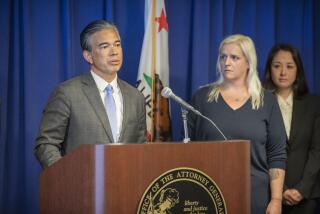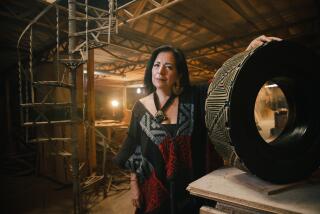$7.1 Million Awarded in Medical Negligence Case : Health: Angela Romero has devoted her life to caring for her quadriplegic daughter, Anissa. But the money to help pay for future care may be held up for another two years.
WEST COVINA — When Angela Romero looks at her 15-year-old daughter, Anissa, she doesn’t see a diapered, 89-pound quadriplegic unable to eat, speak or focus her eyes.
“It’s just like you have a little baby,” Romero said one afternoon as she lovingly patted her daughter’s chest. “You see a very contented little girl. I give her little carinos (endearments), as they say in Spanish. Very seldom does she cry.”
But when a Pomona Superior Court jury last month looked at Anissa, they saw a case of medical negligence.
Fifteen years after Anissa’s birth and seven years after filing a lawsuit, the jury awarded Anissa $7.1 million for future medical care.
The sum was assessed against Dr. Henry Moghtader, a West Covina obstetrician-gynecologist, who delivered Anissa at Queen of the Valley Hospital on Feb. 23, 1977.
Romero’s attorney, Roger Gordon, argued during the three-week trial that Moghtader failed to speedily remove Anissa from her mother’s womb by Cesarean section. Speed was essential, the attorney said, because Romero’s placenta was tearing away from the uterine wall, depriving Anissa of oxygen and immersing the unborn child in an increasingly waste-polluted environment.
Gordon maintained that Moghtader delayed for 30 crucial minutes assembling a surgical team, because he thought the baby was dead. That delay, the attorney argued, caused Anissa to be born with cerebral palsy, profound mental retardation, seizures, severe sight problems and other ailments that have confined the child to a bed or wheelchair for life and left her with the mental capacity of an infant.
Moghtader’s attorney, Steve Saldo, countered during the trial that in 1977 the West Covina hospital had no in-house surgical team and that his client assembled the team as quickly as possible. Romero herself delayed coming to the hospital for two hours after she began experiencing labor symptoms, Saldo said.
After the March 2 jury verdict, Saldo asked for and got a hold on the award while he seeks a reversal from trial Judge Thomas Nuss. If Nuss turns down the request and agrees with the jury, Saldo said he probably will file an appeal.
Moghtader, 69, insists that he is not responsible for Anissa’s condition. A former chief of staff at Queen of the Valley Hospital, Moghtader has practiced for 34 years in West Covina and counts more than 10,000 infant deliveries in his career. The only other lawsuit against him was settled for $12,500, the physician said.
“The jury felt sorry for the girl,” Moghtader said. “Actually, honestly, they have no case.”
The legal process, including appeals, probably will continue for two more years.
Meanwhile, life is not much different for Romero, 45.
“She has allowed me to become the woman I am today; a totally strong woman,” Romero said as she caressed her daughter’s cheek and Anissa smiled. “And my faith in God has increased.”
Because the lawsuit was filed by Anissa, Romero was not allowed to testify about the effect her daughter’s medical condition has had on her own life. But on a recent afternoon, as Anissa sat beside her in their rented home on Sheba Court in West Covina, Romero described what she called the “chiseling, molding experience” of caring for a totally disabled child for 15 years.
“I truly thank God for her,” Romero said as she sat in the kitchen, where there was an open Bible on the counter and a mirrored cross on the wall. “She’s not a burden. She’s a blessing.”
Such in-home care is increasingly becoming the trend, said Ronald Cohen, executive director of the United Cerebral Palsy Assn. of Los Angeles.
Every year, an estimated 3,000 babies nationwide are born with cerebral palsy, he said. Organizations such as his seek to provide in-home services to families to avoid warehousing the disabled in institutions.
“There’s a saying: How do you treat a person with a disability? . . . Like a person,” Cohen said.
Romero said she never considered putting her daughter in an institution or board-and-care home despite early years that took a toll on her. With two other children, a husband and a job, she said she strove to be the perfect wife, mother, worker and nurse for Anissa.
For nine years, she worked a graveyard shift at Southern California Gas Co. and slept two or three hours in the morning to be with Anissa during the day. The intense care was needed because Anissa was in and out of hospitals constantly for respiratory infections, seizures and various operations. In 1982 alone, Anissa was hospitalized seven times, Romero said.
Anissa has had at least 10 operations, including surgery to insert a feeding tube in her stomach, to cap teeth that decayed from daily ingestion of four anti-seizure medications and to cut her stiffened leg muscles so that she could be more easily moved.
Faced with a mountain of responsibilities and occasional bouts of severe depression, Romero said she did not think of filing a lawsuit until a friend suggested that she look at hospital records and ask questions before the eight-year liability period allowed for matters involving doctors passed.
The suit, filed in 1985, originally included the hospital. But after several years of legal wrangling, the medical facility was dropped after it agreed to pay a $275,000 settlement, Gordon said.
Meanwhile, the stress of caring for Anissa, combined with other difficulties, broke up Romero’s marriage. Without another adult to care for Anissa while she was at work, Romero said she had to quit her job as a computer operator.
Now, she gets by on a combination of state, county and federal aid programs for the disabled and their caretakers.
“We’ll huddle and cuddle, I’ll sing little Christian songs to her, or we make up our own jibber-jabber,” Romero said, describing how she and her daughter spend their evenings.
If and when the lawsuit is resolved and money is awarded to her daughter, Romero said she wants to buy a house she could remodel to accommodate Anissa’s needs.
Baths are out for her daughter because Romero said she can no longer lift the child into the tub. Although special hoists exist, she cannot afford them nor can she alter their present home.
Because of the care Romero has given her daughter, medical experts testified during the trial that Anissa will live longer than expected. Based on that testimony, the jury concluded that Anissa will live to age 45 and awarded accordingly.
Romero said she does not expect her two other children to care for Anissa in the future.
Her 23-year-old son, Mark, lives with his father in West Covina, and her 13-year-old daughter, Jennifer, is a junior high school student who lives with Romero.
“My children have their own lives to live,” Romero said. “If something would happen to me, I would make arrangements to have Anissa put in a special home.”
Romero said she might have to face separation from her daughter when she becomes too old to care for her, but it is hard to think about that now.
“I went through my ‘pity parties’ and ‘Why me?’ But I look at her now and there’s such a bond,” Romero said. “I won’t give her up for anybody.”
More to Read
Sign up for Essential California
The most important California stories and recommendations in your inbox every morning.
You may occasionally receive promotional content from the Los Angeles Times.










